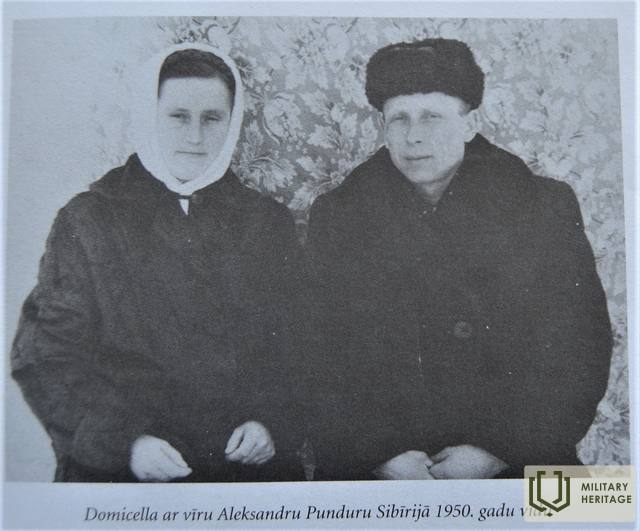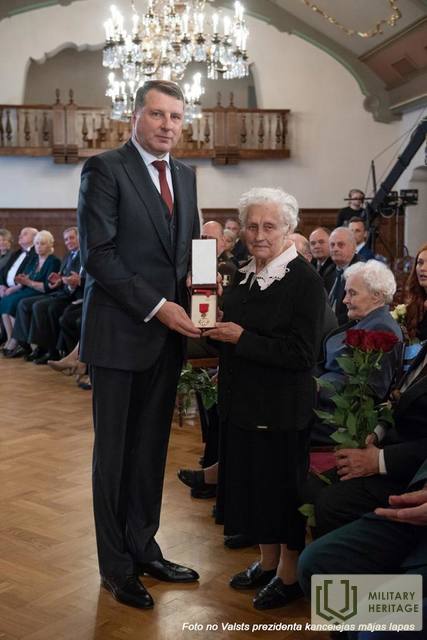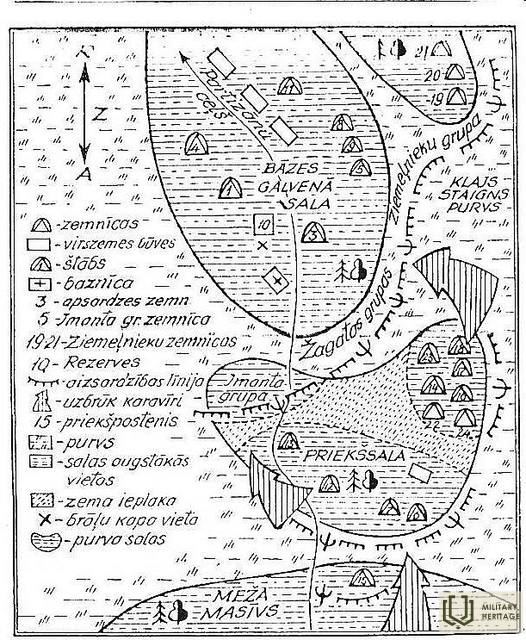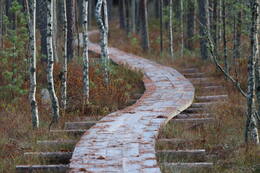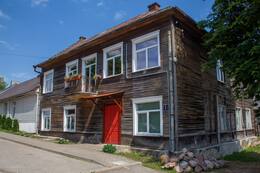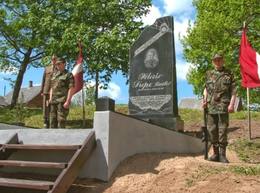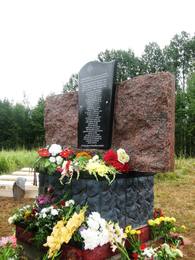Miško dukra Domicella Dwarf (Lucia)
Domicellai Pundure – 90 metų. 2018 m. gegužės 3 d. Rygos pilyje ji iš prezidento Raimondo Vėjonio rankų gavo Viesturo ordiną už ypatingus nuopelnus nacionalinio pasipriešinimo judėjime ir šalies nepriklausomybės gynime. Domicella Pundure yra paskutinė Stompaku pelkės mūšio liudininkė.
Domicella Pundure – nacionalinė partizanė, nuo 1945 m. vasario daugiau nei mėnesį praleidusi Stompakų pelkės gyvenvietėje, kur tuo metu gyveno apie 360 partizanų, tarp jų moterys, vaikai ir pagyvenę žmonės. Ji ištekėjo 1948 m., bet 1949 m. visa jos šeima buvo ištremta į Sibirą, į Omsko sritį. Į Latviją ji grįžo 1960 m. balandį. Jauna šeima nusipirko namą tuometiniame kolūkyje „Borec“, dirbo kolūkio lauko brigadoje. Mirus vyrui, Domicella Pundure 1987 m. rudenį persikėlė į Balvius. Jau išėjusi į pensiją, ji porą metų dirbo viešbučio bufete.
Domicellos Pundur gyvenimo istoriją galima perskaityti Sanitos Reinsonės knygoje „Meža meitas“.
Gimė 1927 m. gruodžio 1 d. Kručinovų šeimos namuose Škilbėnų parapijoje. Baigusi keturias klases netoliese esančioje Augstasilas pradinėje mokykloje, Domicella pradėjo dirbti tėvo ūkyje.
„Mano tėvas buvo sargybinis Latvijos laisvosios valstybės laikais, bet vokiečių okupacijos metu dirbo Škilbėnų policijoje. Kai 1944 m. liepą–rugpjūtį vėl kirto karo frontas, mūsų nebuvo namuose. Kaimynai buvo vietiniai rusai ir jie įkalbėjo mus išvykti. Išvykome, bet jie toli nenuvažiavo, apsistojo pas gimines čia, Balvuose. Taigi po kurio laiko grįžome.“
Bet mano tėvas niekada neišėjo ir daugiau niekada negyveno namuose. Iš pradžių jis visai nepasirodė, bet paskui mes su juo susitikome. Jis daugiau nebepasirodė Ščilbėse. Jie gyveno maža grupe, tik vėliau prisijungė prie didesnės grupės. Tada mano tėvas išėjo į Stompāku pelkę. Vėliau, kai miško broliai labiau susirinko, čekistai pradėjo visus terorizuoti, ir kai jie man atsiuntė šaukimą eiti dirbti į durpyną, mano tėvas 1945 metų vasarį mane pasiėmė su savimi. Jie mane arkliu nuvežė į Stompukus. Nuėjau į mišką su tuo, ką turėjau ant nugaros, ir tai buvo viskas. Rožinį, taip, turėjau jį su savimi – jis turėjo būti su savimi. Ir mes ėjome, meldėmės, ir Dievas mus apsaugojo. Kas turėjo kristi, tas krito.
Stompako miškas nebuvo tankus, o stovykla buvo netoli kelio. Pagrindiniu keliu nevažiavome, ten galėjome važiuoti tiesiai per miškus. Žiemą, kai miško darbai būdavo baigti, keliai jau būdavo nutiesti palei linijas. Kiekvienas stovykloje turėjo vardą. Mano tėvas turėjo vardą Irbītis, o aš, regis, – Lucija. Kol stovykloje neprasidėjo kovos, darėme tai, kas mums buvo liepta. Kiekviename bunkeryje buvo po vieną vyresnįjį, ir jis vadovavo. Gyvenau bunkeryje su tėvu. Žiemą nebūdavo šalta. Turėjome nedidelę krosnelę, kurioje gamindavome maistą. Sienos buvo iš rąstų. Jos buvo pakankamai aukštos, kad galėjai atsistoti, ir buvo gultai, kur kažkas miegodavo viršuje, o kažkas apačioje. Kai kurie bunkeriai buvo didesni, kai kurie mažesni. Buvo su daugiau žmonių, kai kurie su mažiau. Taip pat buvo arklių. Prie mūsų bunkerio buvo trys arkliai. Jie turėjo tokias trobeles, padarytas iš eglių šakų. Jie taip pat krito mūšyje.
Apskritai tuose Stompakuose buvo nemažai moterų. Buvo ir vaikų. Mažų vaikų. ... Netgi buvo specialus bunkeris, kuriame kepdavo duoną. Bet apskritai kiekviename bunkeryje jie patys rūpindavosi savo maistu – kur tik gaudavo, eidavo pas gimines arba pas šeimą, kuri jo turėdavo namuose. Maistas būdavo kaip iš kaimo. Kaip ir žiemą, būdavo paskerstų kiaulių, mėsos, varškės, pieno. Nereikėjo badauti... Man sakė, kad Stompakuose bunkeriai buvo sunumeruoti arba kad tie numeriai dabar įvesti. Mūsų buvo šeštasis bunkeris.
Mes nelabai vaikščiojome po bunkerius stovykloje ir nematėme nieko kito. Kitus sutikome stovyklos bažnyčioje ir čia bei ten. Bažnyčia buvo pačioje stovykloje. Mano vyras ir jo brolis padėjo ją pastatyti. Tai buvo toks mažas bunkeris, kad tilpo ne daugiau kaip dvidešimt žmonių. Į bažnyčią ateidavo katalikai. Kiekvieną rytą vykdavo pamaldos. Ir jie ten net klausydavo išpažinčių. Kunigas buvo iš Škilbėnų – Ludvigas Štagaras.
Maždaug tą dieną, kai 1945 m. kovo 2–3 d. vyko mūšis. Šaudymas prasidėjo anksti ryte. Nežinojau, kas vyksta. Žmonės bėgiojo po stovyklą. Mudu su tėvo seserimi buvome bažnyčioje. Ir mes tiesiog ten tupėjome visą dieną. Vėliau pas mus pradėjo vežti sužeistuosius. Jų buvo daug. Turėjome paramediką iš Viliakos Romaną. Jis buvo mūsų vadas. Padėjome, kiek galėjome – tvarstėme sužeistuosius, davėme jiems, ko jiems reikėjo, ir darėme visa kita. Ten susipažinau su savo būsimu vyru. Jis buvo sužeistas į koją. Ir tada mums viskas prasidėjo.
Apskritai toje didelėje stovykloje buvo saugu, bet tą mūšio dieną... buvo baisu. Siaubas, koks triukšmas kilo! Mes tiesiog bijojome. Po mūšio jie jau kalbėjo apie visokius dalykus, bet vis tiek, matote, mūsų vyrai priešinosi. Vyrai turėjo visokių ginklų, jų buvo nemažai. Svarbiausias asmuo stovykloje buvo Pēteris Supe, bet aš jo nemačiau. Ir tą patį vakarą mes išėjome. Sužeistuosius išvežė arkliais. Tie iš mūsų, kurie buvome visiškai, kaip sakoma, sveiki, visi stiprūs, išėjome. Nepamenu, kiek mūsų buvo, bet nebuvo daug. Klajojome po mišką, per pelkę, per mišką. Vyrai, žinoma, turėjo su savimi ginklų. Ėjome naktį pėsčiomis. Kitą vakarą išėjome į buvusią Barecą, į namą pačiame miško pakraštyje. Davė mums arbatos atsigerti. Ir tikriausiai davė duonos, nes išėjome visiškai tuščiomis rankomis, viskas, kas buvo bunkeryje, ten ir liko.
Ir tada mūsų grupė iširo. Mudu su tėvu grįžome namo. Bet jis nebegyveno namuose. Taigi niekas manęs daugiau nelietė, niekur neėjau teikti prašymų ar registruotis, gyvenau name. Pasirodo, mėnesį gyvenau miške.“
1945 m. kovo 2 d., stovykloje esant apie 300 žmonių, sovietų kariuomenės dalinys puolė pelkę. Beveik 24 valandas miško broliai priešinosi maždaug 500 žmonių priešo pajėgoms. Mūšyje žuvo arba nuo žaizdų mirė 28 partizanai ir 46 sovietų kareiviai. Žuvusių miško brolių palaikai buvo eksponuojami Viliake ir kai kuriuose aplinkiniuose kaimuose, siekiant įbauginti vietos gyventojus.
http://www.balvurcb.lv/kb/?View=entry&EntryID=1078
Citatos iš Sanitos Reinsonės knygos „Miško dukros“
Susijusi laiko juosta
Susijusios temos
Susijusios vietos
Nacionalinių partizanų būstinė gamtos draustinyje „Stompakų pelkės“ (Stompaku purvi)
Antrojo pasaulinio karo metais Stompakų pelkėje buvo viena didžiausių nacionalinių partizanų būstinių Baltijos šalyse. Šiandien ši teritorija priklauso Stompakų gamtos draustiniui. Pelkių salose esančią gyvenvietę galima pasiekti pažymėtu pėsčiųjų taku.
1945 m. pradžioje Stompakų pelkėje buvusioje nacionalinių partizanų būstinėje gyveno 350–360 žmonių, iš jų – 40 50 moterų. Joje buvo 24 gyvenamieji bunkeriai – pusiau į žemę įkasti statiniai, kuriuose galėjo gyventi 3–8 žmonės. Būstinėje taip pat veikė kepykla, požeminė bažnyčia ir trys antžeminės pašiūrės arkliams. Partizanai rengė išpuolius prieš okupacinio režimo pareigūnus.
1945 m. kovo 2–3 d. čia vyko Stompakų mūšis – didžiausias nacionalinių partizanų susirėmimas Latvijoje. Būstinėje buvusius 350–360 partizanų puolė NKVD 143-asis šaulių pulkas ir vietinio stribų (rus. „isterbiteli“) bataliono kovotojai – iš viso 483 vyrai. Mūšis truko visą kovo 2 dieną. Kovo 3-iosios naktį partizanams pavyko ištrūkti iš būstinės ir pasitraukti į ankstesnės bazės vietą. Mūšyje žuvo 28 partizanai, o NKVD neteko 32 karių.
Šiuo metu Stompakų būstinės vietoje yra atkurti trys bunkeriai – bažnyčia, štabas ir gyvenamasis bunkeris, taip pat 21 bunkerio vieta. Įrengti informaciniai stendai apie būstinę ir mūšį. Galima užsisakyti ekskursijas su gidu.
Privati ekspozicija „Abrenės kambariai“ (Abrenes istabas)
Privati ekspozicija „Abrenės kambariai“ įsikūrusi Viliakos mieste, istoriniame pastate. Iš pradžių šis pastatas stovėjo senosios Marienhauzeno turgaus aikštėje. Vėliau čia veikė butai, biurai, įvairios parduotuvės, o Antrojo pasaulinio karo metais – latvių savigynos štabas, gestapas ir čekistų būstinė. Ekspozicijose pristatomi įvairūs Viliakos ir jos apylinkių istorijos laikotarpiai bei įvykiai nuo 1920 iki 1960 metų – kai miestelis priklausė Jaunlatgalės, vėliau Abrenės apskričiai. Tarp eksponatų – Stompakų pelkės partizanų štabo daiktai, pasakojantys apie nacionalinį pasipriešinimą Latgaloje, taip pat dokumentai ir fotografijos iš Nepriklausomybės kovų laikotarpio. Naujausioje ekspozicijoje lankytojai gali susipažinti su kadaise garsia motokroso trasa „Baltasis briedis“
Paminklas Šiaurės Rytų nacionalinių partizanų vadui Pēteriui Supei – „Cinītis“
Pagerbiant nacionalinių partizanų vado Pēterio Supės atminimą, 2005 m. gegužės 28 d. Viliake buvo atidengtas jam skirtas paminklas. Jis stovi netoli Viliakos katalikų bažnyčios, karo metu iškastų apkasų pakraštyje, kur čekistai laidojo sušaudytus nacionalinius partizanus. Po P. Supės paminklu įdėta kapsulė su 386 žuvusių nacionalinių partizanų vardais, mūšių aprašymais ir medžiaga apie partizanų vadą. Akmenyje iškalti žodžiai: „Tau, Latvija, likau ištikimas iki paskutinio atodūsio“.
Paminklą suprojektavo Pēteris Kravalis.
Netoliese yra memorialas Latvijos laisvės kovotojams, žuvusiems Stompaku miške ir kitose mūšių vietose bei nužudytiems čekistų 1944–1956 m.
2008 m. birželio 20 d. dešinėje sienoje buvo atidengta granito lenta su trimis stulpeliais išdėstytais 55 žuvusių partizanų vardais.
Paminklas pastatytas toje vietoje, kur komunistinė okupacinė valdžia kadaise eksponavo nužudytų partizanų palaikus, siekdama įbauginti likusius gyventojus.
Ant greta esančios lentelės išgraviruoti padėkos žodžiai Pēteriui Supei ir Bronislavos Martuževos eilėraštis:
"Kelkis, Piteri Supe,
Siela, kovok kare!
Šiandien tavo kraujo auka,
Iškilo tarp žmonių.
Išeik ir gyvenk amžinai
Jaunystės stiprybėje ir energingoje
Jis plasnoja, plasnoja, plasnoja
"Kylančioje vėliavoje!"
Paminklas pasipriešinimo judėjimo dalyviams Stompakyje
Įsikūręs 15 km nuo Balvių, Viljakos kryptimi, dešinėje kelio pusėje.
Matomas atminimo ženklas.
2011 m. rugpjūčio 11 d., minint Latvijos laisvės kovotojų atminimo dieną, Balvu–Viliako plento pakraštyje priešais Stompakų pelkę buvo atidengtas pasipriešinimo judėjimo dalyvių memorialas, skirtas Pēterio Supės tautinių partizanų, žuvusių 1945 m. kovo 2 ir 3 d. mūšiuose, atminimui. Liepos pabaigoje į paminklo pamatus buvo įkasta kapsulė su žinia ateities kartoms. Kapsulėje įdėtas dokumentas su 28 tautinių partizanų, žuvusių 1945 m. kovo 2 ir 3 d. mūšiuose, vardais ir pavardėmis.
„1945 m. vasarį Stompakų pelkės salose, kurias žmonės pradėjo vadinti Stompakų pelkės salelėmis, 2 km nuo Balvų–Viliakos plento, buvo įkurta didžiausia Latvijoje nacionalinė partizanų stovykla, kurioje 22 apkasuose gyveno 360 žmonių. Tarp jų buvo ir legionierių, kurie, legiono divizijai atsitraukiant, su visais ginklais buvo pasilikę tėvo namuose. Siekdami sunaikinti partizanus, 1945 m. kovo 2 d. dviejų Čekos batalionų kareiviai kartu su naikintojais, kurių ginkluotėje taip pat buvo keturi minosvaidžiai, puolė apkasus. Kovos tęsėsi visą dieną, partizanai atkakliai priešinosi, o puolėjai patyrė didelių nuostolių, todėl negalėjo užimti stovyklos ir sunaikinti partizanų. Mūšyje žuvo arba nuo sunkių sužalojimų mirė ir 28 Stompakų pelkės gyventojai. Kitą naktį partizanai mūšiu „praėjo apgultis ir liko nenugalėtas“ prasiveržė pro stovyklas – taip rašė Zigfrīds.“ Apdovanojimų skyriaus Nacionalinio pasipriešinimo judėjimo dalyvių reikalų komisijos pirmininkas Berkis rašo apie Stompako mūšį.




